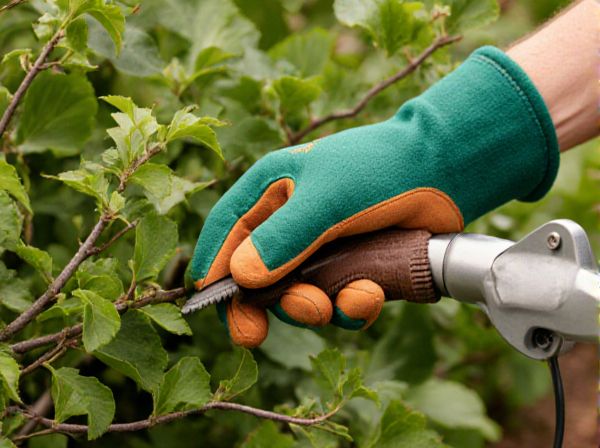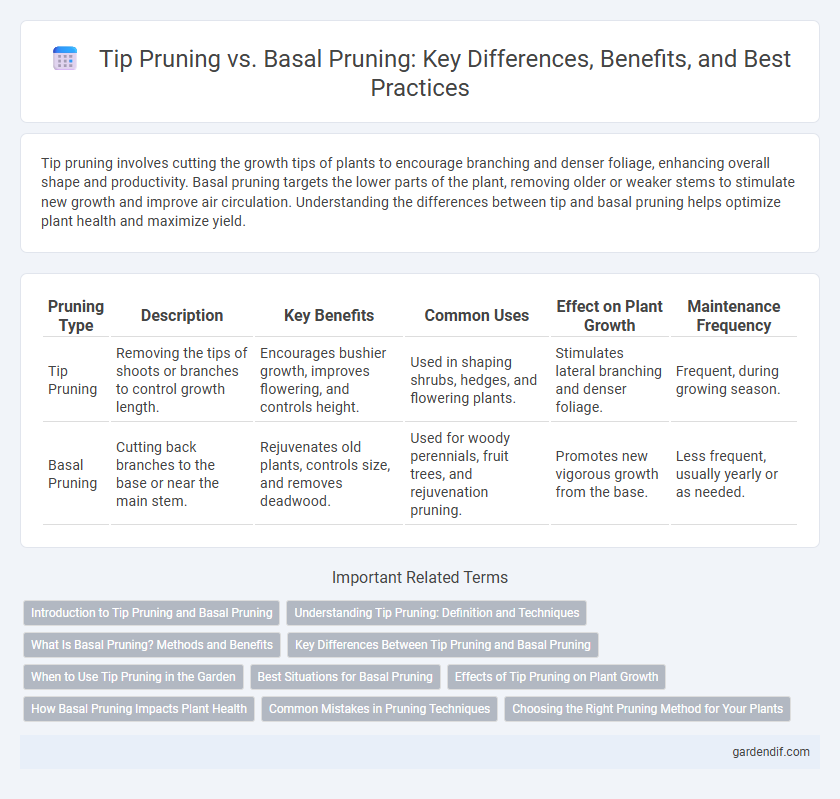
Tip pruning vs basal pruning Illustration
Tip pruning involves cutting the growth tips of plants to encourage branching and denser foliage, enhancing overall shape and productivity. Basal pruning targets the lower parts of the plant, removing older or weaker stems to stimulate new growth and improve air circulation. Understanding the differences between tip and basal pruning helps optimize plant health and maximize yield.
Table of Comparison
| Pruning Type | Description | Key Benefits | Common Uses | Effect on Plant Growth | Maintenance Frequency |
|---|---|---|---|---|---|
| Tip Pruning | Removing the tips of shoots or branches to control growth length. | Encourages bushier growth, improves flowering, and controls height. | Used in shaping shrubs, hedges, and flowering plants. | Stimulates lateral branching and denser foliage. | Frequent, during growing season. |
| Basal Pruning | Cutting back branches to the base or near the main stem. | Rejuvenates old plants, controls size, and removes deadwood. | Used for woody perennials, fruit trees, and rejuvenation pruning. | Promotes new vigorous growth from the base. | Less frequent, usually yearly or as needed. |
Introduction to Tip Pruning and Basal Pruning
Tip pruning targets the terminal buds of a plant, encouraging lateral growth and bushier development by removing shoot tips. Basal pruning involves cutting back stems near the base, promoting stronger root systems and rejuvenating older growth for healthier plant structure. Both methods optimize plant growth strategies based on species and desired horticultural outcomes.
Understanding Tip Pruning: Definition and Techniques
Tip pruning involves selectively removing the apical growth or shoot tips to control plant height, promote bushier growth, and encourage lateral branch development. Techniques include pinching, cutting just above a leaf node, or using shears to remove soft growth, which triggers hormonal changes that redistribute nutrients to side shoots. This method contrasts with basal pruning, which targets older, lower stems to rejuvenate the plant and improve air circulation.
What Is Basal Pruning? Methods and Benefits
Basal pruning involves selectively removing lower branches and shoots near the base of a plant or tree to enhance air circulation and reduce disease risk. Common methods include thinning, where entire branches are removed, and heading cuts that shorten only part of a branch to encourage healthy new growth. This technique improves overall plant structure, increases light penetration, and supports stronger, more vigorous development in the upper canopy.
Key Differences Between Tip Pruning and Basal Pruning
Tip pruning targets the upper part of the plant by removing shoot tips to encourage lateral growth and bushier structure, while basal pruning involves cutting back the lower stems or branches to rejuvenate the plant and promote new growth from the base. Tip pruning primarily influences plant height and shape, whereas basal pruning focuses on improving overall plant vigor and health by eliminating old or weakened growth. Understanding these key differences helps optimize pruning strategies for specific horticultural goals such as increased yield or enhanced plant aesthetics.
When to Use Tip Pruning in the Garden
Tip pruning is best used during the active growing season to encourage bushier plant growth and to shape young plants by removing the terminal buds. This method is particularly effective for herbs, shrubs, and flowering plants that benefit from controlled height and enhanced branching. Use tip pruning when you want to stimulate new growth without weakening the plant's overall structure.
Best Situations for Basal Pruning
Basal pruning is most effective in situations where dense undergrowth or lower branches impede airflow and sunlight penetration, such as in vineyards or orchards with tightly spaced plants. This method promotes better air circulation and reduces the risk of fungal diseases by removing lower shoots that harbor moisture. It is ideal for managing vigor in young plants and maintaining structural balance without compromising fruit quality.
Effects of Tip Pruning on Plant Growth
Tip pruning stimulates lateral bud development by removing apical dominance, resulting in bushier plant growth and increased foliage density. This method redirects plant energy from vertical elongation to the expansion of side shoots, enhancing overall plant shape and fullness. In contrast, basal pruning primarily encourages root development and has less immediate impact on above-ground shoot proliferation.
How Basal Pruning Impacts Plant Health
Basal pruning significantly improves plant health by removing older, woody stems near the root system, which stimulates new growth and enhances nutrient uptake. This technique reduces disease risk by eliminating damaged or infested basal parts, promoting better air circulation and sunlight penetration within the plant structure. Compared to tip pruning, basal pruning fosters stronger root development and overall plant vigor, leading to higher yield and longevity.
Common Mistakes in Pruning Techniques
Tip pruning often leads to excessive foliage regrowth and weak branch structures if cuts are made too close to the bud, while basal pruning mistakes include removing too much low growth, which can reduce the plant's overall vigor. Misapplying either technique can cause stress, making plants susceptible to diseases and pest infestations. Proper identification of pruning points and understanding plant growth habits are crucial to avoid common errors in both tip and basal pruning practices.
Choosing the Right Pruning Method for Your Plants
Tip pruning targets the upper growth of shoots to encourage bushier plants and more blooms, making it ideal for ornamental and flowering species. Basal pruning removes older, woody stems near the plant's base to stimulate healthy regrowth and rejuvenation, commonly used for shrubs and perennials. Selecting the appropriate pruning method depends on plant type, growth stage, and desired outcomes for optimal health and appearance.
Tip pruning vs basal pruning Infographic

 gardendif.com
gardendif.com